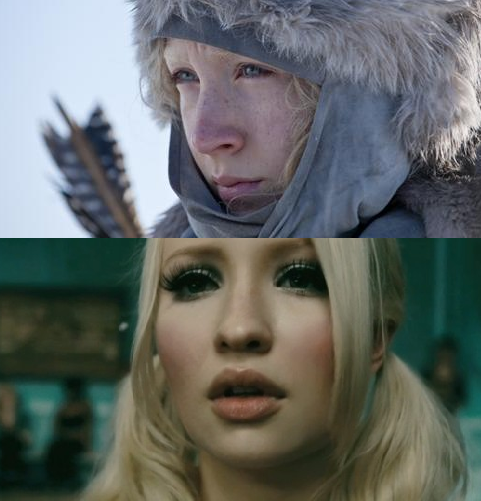The Young-Girl doesn’t look like a dead body, as one might presume from reading women’s magazines; she looks like death itself.
Tiqqun, Raw Materials for a Theory of the Young-Girl
Sucker Punch, the first original project from Zack Snyder (known for his adaptations of comic books like 300 and Watchmen) is ostensibly the story of Babydoll (Emily Browning), a 20 year old cleverly disguised as a child prostitute in a world full of sexual predators. When her mother dies and step-dad takes over, it doesn’t take watching the rest of Snyder’s movies to see where this is going. Step-dad (Gerard Plunkett) locks Babydoll in her room and heads for little sister (alive for like two seconds). By the time Babydoll gets out the window and back into the house, little sister is already dead. She finds a gun, shoots and misses, puts down the gun, and runs outside where she’s arrested for her sister’s murder. Step-dad does what you do with troublesome step-daughters and has her committed to a mental asylum for girls.
Just as Babydoll is about to be lobotomized, we start the Inception-style dream within a dream layering of narratives. From here on out, Sucker Punch is sort of like Charlie’s Angels, if the angels were projecting themselves into video game fantasies to psychologically escape living death and the constant fear of sexual abuse. The main “reality” level for most of the film is a bordello specializing in white slavery, run by a cruel pimp (Oscar Isaac, also the corrupt and leering orderly) from where the girls plot to escape in the imagined terms of easily defined tasks: kill giant demon samurai, kill the androids from iRobot, kill ogres and dragons straight out of Tolkien. This all has something to do with sexy dancing. Babydoll gets a big sword.
Snyder’s world(s) are inhabited by two main archetypes: damaged nubile girls and lecherous men. In Sucker Punch there is not one rape even though the audience is made to fear imminent sexual violence for approximately 80 percent of the movie. Even the killer androids grab like creepy uncles. When we get a shot of the fat blotchy cook’s sandwich piled high with greasy meat, we know it’s only a matter of time. As happens to little sister in the opening scene, in place of consummated rape Snyder unfailingly inserts homicide, miraculously preserving a PG-13 rating despite the point-blank execution of two barely-legal sex slaves. There is not an instance of even implied intercourse in Sucker Punch. When one of the girls (Jena Malone) explains to newcomer Babydoll what happens at the brothel, she resorts to only the vaguest of vague euphemisms. The characters are genital-less Barbie-whores and Ken-pimps whose entire libidinal economy consists of aggression, fear, and death.
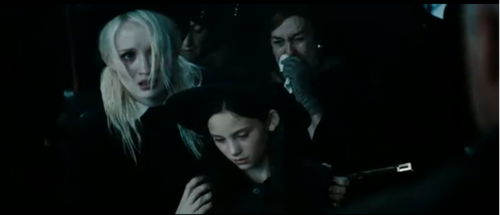
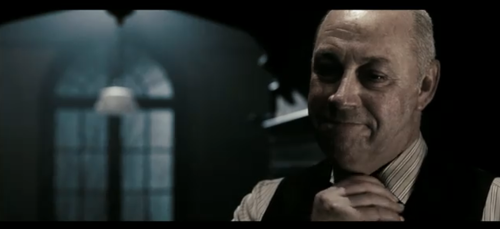
By equating rape and murder so directly, Snyder defines the film’s power relations. The existence of what the viewer is constantly reminded are vulnerable girls makes every shot the start of a potential rape scene. But if rape is equivalent to murder, then this imbalance turns to a series of struggles to the death. And as the novelist/art-critic John Berger writes, “once death is invoked, the choice of who must die may seem oddly arbitrary.” The power of the young-girl in Sucker Punch comes from this dialectical ambiguity: her presence in the film is both an invocation of her own rape (murder), and at the same time the unavoidable possibility that the struggle will go the other way. This is the dialectic of “power-over” which can only realize itself against resistance, and thus always includes internally its potential reversal.
The resolution in Sucker Punch, however, doesn’t muster much of structural critique. Out of our five heroines, three end up dead, one lobotomized, and one escapes back to her parents with whom she never had any problems to begin with. Babydoll is the protagonist for the near entirety of the film, but the introduction gives her nowhere to run. At the moment of truth, she must sacrifice herself so that another can live, or at least fight not to die somewhere else. The freedom to “be yourself” doesn’t seem to have much to offer those whose only two defining characteristics seem to be their drive to survive and their susceptibility to rape. The circuit of power in Sucker Punch leaves no way out: Either kill your rapist or he will kill you, and then do it again and again. The viewer never gets a hint that the girls of Sucker Punch desire anything, not even a token hobby or interest, no suggestion that they are capable of something beyond death itself.
Hanna, on the other hand, in addition to being a much more enjoyable film, is about a different kind of power and a different kind of young-girl. In this film from writer Seth Lochhead and director Joe Wright (Pride and Prejudice, Atonement), the titular Hanna is a teenage killing machine, trained her whole life in an isolated arctic cabin (hints of Rocky IV) by her former-secret-agent father (Eric Bana). She speaks all the languages, hunts for food, knows a bunch of useful secret agent factoids about countries she’s never seen, and spars viciously. When Hanna starts to get antsy to go explore – as teenagers, isolated or not, are wont to do – her father goes into the forest and digs up a small box. Inside the box is a small metal switch and a red light. He tells her that when she chooses to flip the switch, Marissa (a delightfully icy Cate Blanchett as a sad and sinister government agent) will know her location. From then on, it will be a fight to the death, after which, if Hanna survives, she can go into the world.
One day, when Hanna decides to stay home while dad hunts, she examines the box more closely. She reaches a finger tip to graze the matte switch and recoils like, well, like she just touched for the first time a button-shaped bundle of nerves she didn’t know existed. The clitoral imagery isn’t exactly subtle but, perhaps due to the relative paucity of such depictions, it’s certainly more so than Sucker Punch’s giant weapon-cocks. The next time dad goes out alone, he comes back to find the light flashing and Hanna standing next to it, ready to begin her own life. Some girls have to recite Torah passages in public, Hanna has to kill a government agent.
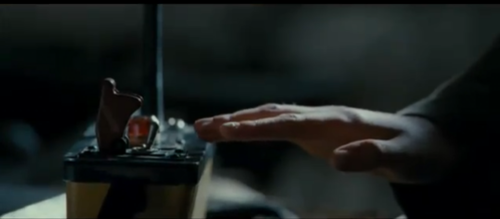
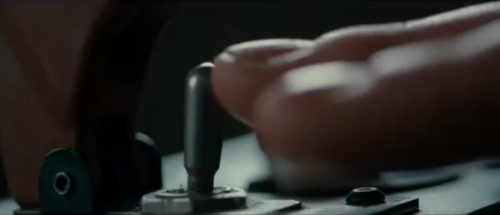
Dad takes off into the woods as soldiers rapidly descend on the cabin to discover not the rogue agent they were looking for, but a scared girl. After escaping from a heavily secured government facility under the Moroccan desert where she was taken, Hanna joins up with a family of British tourists and makes her first friend, the daughter Sophie (Jessica Barden). Whereas Sucker Punch depicts no nuclear family yet posits it as the only thing worth living for, Hanna does the opposite. The British mother (the underrated Olivia Williams) is portrayed as both free-spirited and intellectual while dad (Guy Ritchie favorite Jason Flemyng) is goofy and playful; they’re generous to this stranger without being paternal or condescending. The one implied act of sex in either film is Sophie rolling her eyes as she and Hanna walk past the parents’ shaking camper. But Hanna never wants to join the family and the parents don’t take pity or try to adopt her. The mother even admonishes the father to respect different parenting techniques, remembering her own time island-hopping around Greece at the same age.
These scenes frame Hanna’s power in terms of potential or “power-to-become.” She is raw becoming, energy without direction. Sure she can kill highly trained agents with her own hands, but she can also ride on a moped with a cute unthreatening Spanish boy (even if when she tries to kiss him he ends up on the ground in a headlock). The tender peck between Hanna and Sophie – half friendship, half experimentation, all affection – stands in stark contrast to Sucker Punch’s sexuality which is exercised only against or over. Hanna dresses in shapeless clothes, and despite the kill team tracking her, is never once the object of implied of threatened sexual violence. It’s not that Hanna is de-sexualized, it’s that the unfolding of that sexuality isn’t already determined by powers beyond her control.
Hanna ends with a deadly showdown in Berlin. After Marissa kills Hanna’s father (and a flashback reveals she killed Hanna’s mother as well), the two must finish what the switch started. As Hanna tries to save her new life too quickly she shouts to Marissa, “I don’t want to do this anymore!” Bred and raised as a killer, she prefers being a teenager. In the last moments they shoot each other non-lethally: Hanna hit with a bullet, Marissa with an arrow. As they fight over the loose gun, Hanna, victorious, stands over her opponent. If Hannawere a worse film than it is, this is when she would realize she didn’t want to be a killer any more and put the gun down. But she knows the only way to live life as anything else is to pull the trigger, and that’s what she does.
Sucker Punch starts with Babydoll orphaned, putting down a gun, and ends with the symbolic penetration of the lobotomy, whereas Hanna starts with the flicking of the clitoral switch and ends with the newly orphaned girl picking up a pistol. Both characters create more than their share of corpses, but Babydoll’s ability to kill is her essential nature, which reaches its apex in the decision to sacrifice her very self-hood. She could never have been anything other than a baby doll, and ends as a rag doll. But Hanna is forced to kill in order to access her potential alterity. It’s not the killing that makes her a killer, but the inability to be otherwise, a block she removes with a bullet. Both films are about female adolescence as a struggle, but only Hanna asks: “As a struggle for what?”
Young women’s bodies are the objects of disproportionate and often undesired abstract cultural and concrete personal attention; we see them inked on magazine covers and chopped up by the borders of advertisements, always the same, bodies frozen at the moment of purest possibility. This is not just the biological potential associated with the first years of menstruation, but also the surplus of life that comes at the cusp of adulthood. In Sucker Punch this potential is on display for the viewers, represented on screen by the crowds at the brothel watching the girls dance. Babydoll adapts to a mental hospital, a bordello, and steampunk Nazi zombies, but it adds up to no more than a series of costumed lap dances. Hanna goes to war with what-is on behalf of what-could-be, for the freedom not to be who she is (how could she know that?), but to find out what she can become.
Ultimately both Babydoll and Hanna halt the objectifying surveillance, the former by becoming pure object, the latter by shooting her objectifier. With Hanna, the camera goes dead at the sound of the final gunshot. InSucker Punch, the vicious orderly is ultimately unable to assault Babydoll because she can no longer resist or meet his gaze. Bare life or pure potential, here is the larger cultural fear: not that the young-girl could invert her own domination, but that she might break out of the circuit altogether.
